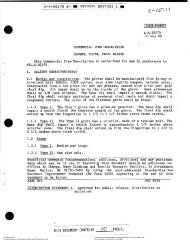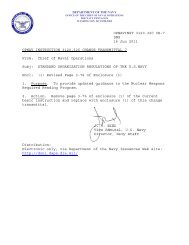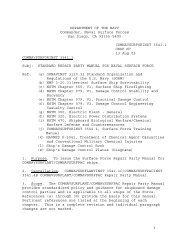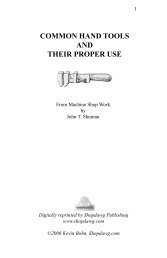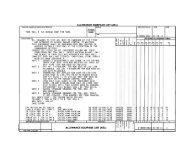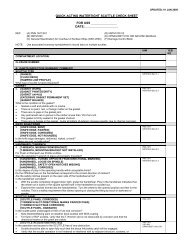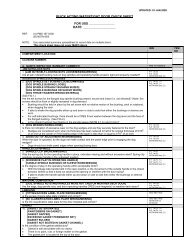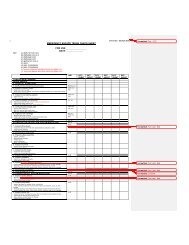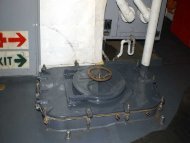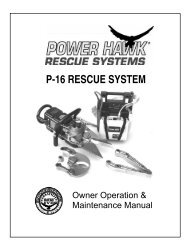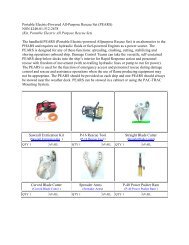JOINT FLEET MAINTENANCE MANUAL
JOINT FLEET MAINTENANCE MANUAL
JOINT FLEET MAINTENANCE MANUAL
Create successful ePaper yourself
Turn your PDF publications into a flip-book with our unique Google optimized e-Paper software.
I-4-3<br />
COMFLTFORCOMINST 4790.3 REV A CH-2<br />
4.3.3 Scheduling. Fast Cruise is scheduled immediately prior to underway trials. Approximately 7 days prior to the<br />
first underway trial, the Supervising Authority with the concurrence of the CO/OIC notifies the Ship Program<br />
Manager that the ship is ready to commence Fast Cruise (Volume I, Chapter 2, paragraph 2.4.1.v of this manual<br />
refers).<br />
4.3.4 Specific Test Areas. Appendix B of this chapter lists the minimum evolutions and drills to be conducted<br />
during Fast Cruise. Additional drills and evolutions are at the discretion of the PCO or OIC. References (b) and (c)<br />
provide additional information for Nuclear Powered Aircraft Carriers, reference (e) for non-nuclear surface ships.<br />
4.3.5 Reports (Nuclear Powered Ships only). The Supervising Authority with concurrence from the PCO/OIC<br />
reports the successful completion of Fast Cruise using the format of Volume I, Chapter 2, Appendix B7 of this<br />
manual (submarines only). Volume I, Chapter 2, paragraph 2.4.1 of this manual refers.<br />
4.4 SEA TRIALS.<br />
4.4.1 General.<br />
a. The policies, procedures and responsibilities pertaining to Sea Trials for ships undergoing construction<br />
are set forth with reference (d). References (a), (f), (g) and (h) augment the basic instruction.<br />
b. Sea Trials for the various platforms undergoing construction differ in complexity, conduct and scope of<br />
Ship's Force involvement. Non-nuclear platforms such as the DDGs or LHDs go through Builder's<br />
Trials (BT) which for the most part are conducted with little to no involvement by Ship's Force.<br />
Industrial activity employees take the ship to sea and perform the majority of system/equipment testing.<br />
Paragraph 4.4.2 of this chapter provides additional information concerning BTs.<br />
c. Nuclear powered ships' Sea Trials, however, are much more orientated to Ship's Force involvement.<br />
Ship's Force is responsible for taking the ship to sea and operating all shipboard equipment. The terms<br />
Alpha Trial, Bravo Trial, Charlie Trial, Combined Trial (CT) and Guarantee Material Inspection (GMI)<br />
are most often associated with submarine Sea Trials whereas Nuclear Powered Aircraft Carriers<br />
undergo BTs prior to Acceptance Trials (AT). Subsequent paragraphs provide amplifying information<br />
concerning these trials.<br />
d. Underway trials following construction, particularly initial submerged and test depth trials for<br />
submarines, must be undertaken with the knowledge that the crew lacks recent experience operating as<br />
a unit and that the ship's structure and fittings have not been tested in an at-sea environment. All tests<br />
and procedures must be conducted carefully and methodically. In the case of submarines, systems and<br />
components designed to operate at test depth should not be exercised at test depth for the sole purpose<br />
of proving the design. They should be operated at the deepest depth at which they might be used.<br />
Trials and tests which are inherently hazardous should not be conducted. For example, a submarine's<br />
hovering system should not be demonstrated at test depth. Reference (i) provides additional<br />
information concerning the testing of submarine seawater systems during underway Sea Trials. Sea<br />
Trials following new construction are normally conducted with a significant number of "riders". These<br />
riders represent Naval Sea Systems Command (NAVSEA), TYCOM, Shipbuilder and Board of<br />
Inspection and Survey (INSURV) personnel onboard to observe various tests and trial evolutions. The<br />
ship's normal loadout of Lithium Hydroxide canisters, Emergency Air Breathing (EAB) masks, Steinke<br />
Hoods/Submarine Escape Immersion Ensemble suits (as applicable), and Lithium Hydroxide curtains is<br />
not sufficient to support this increase in personnel. Therefore, four additional Lithium Hydroxide<br />
canisters, one EAB mask, one Steinke Hood/Submarine Escape Immersion Ensemble suit (as<br />
applicable), and four Lithium Hydroxide curtains must be carried for each rider exceeding normal crew<br />
manning. Lithium Hydroxide canisters, EABs, Steinke Hoods/Submarine Escape Immersion Ensemble<br />
suits (as applicable), and Lithium Hydroxide curtains are to be obtained from the industrial activity.



